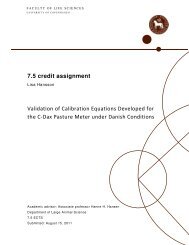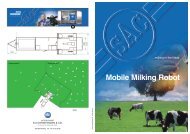Innovative Technology and Sustainable Development of Organic - 1.
Innovative Technology and Sustainable Development of Organic - 1.
Innovative Technology and Sustainable Development of Organic - 1.
Create successful ePaper yourself
Turn your PDF publications into a flip-book with our unique Google optimized e-Paper software.
Abstract<br />
<strong>Development</strong> <strong>of</strong> organic dairy farming in Denmark is characterized by up-scaling, increasing<br />
productivity <strong>and</strong> automation. Increasing discussion on compliance with organic principles <strong>and</strong><br />
sustainability has been forwarded. Automatic milking systems (AMS) are part <strong>of</strong> this development <strong>and</strong><br />
have been implemented in organic dairy production in Denmark the last 10 years. The systems’<br />
consequences on economic, ecological <strong>and</strong> societal issues were unknown.<br />
The general objective <strong>of</strong> the PhD assignment was to assess the contribution <strong>of</strong> new technologies to<br />
the sustainable development <strong>of</strong> organic dairy farming (i.e., determine economic, ecological <strong>and</strong> societal<br />
consequences), using AMS as a case for the present technological situation.<br />
To evaluate sustainability, a framework was used which adhered to the following consecutive steps:<br />
‘identification <strong>of</strong> sustainability issues by involving identified stakeholders’, ‘quantification <strong>of</strong><br />
indicators defined for these issues <strong>and</strong> investigating them’ <strong>and</strong> ‘evaluation <strong>of</strong> obtained results by using<br />
them in goal-vision based scenarios, again involving relevant stakeholders’. Focus group interviews<br />
<strong>and</strong> questionnaires revealed general concerns among farmers <strong>and</strong> consultants on the grazing<br />
possibilities when using AMS, as well as milk quality aspects <strong>and</strong> economy. Quantification <strong>of</strong><br />
indicators on sustainability, where farms using AMS were compared with non-users, showed higher<br />
milk yield, lower labour use, <strong>and</strong> differences in some management aspects like higher culling rate <strong>and</strong><br />
also a shorter grazing time when using AMS. The shorter grazing time especially could compromise<br />
the sustainability <strong>of</strong> the system, as grazing is essential for the customers buying organic dairy products.<br />
A focussed experiment showed how cows perform <strong>and</strong> react following a reduction in grazing time,<br />
while stimulated to eat fresh grass by limiting supplementary feed in the barn. High compensation<br />
ability <strong>of</strong> the cows was seen, with increased grass uptake <strong>and</strong> limited negative consequences on milk<br />
yield. However, cows were provoked to be more active when outside <strong>and</strong> the relatively high <strong>and</strong> large<br />
amount <strong>of</strong> grass eaten in short time span could be registered in the milk quality. Finally, goals <strong>and</strong><br />
visions <strong>of</strong> future sustainable organic dairy farming were deduced from participative sessions with<br />
stakeholders <strong>and</strong> used for scenario definition. Subsequently, three goal-vision based scenarios were<br />
parameterized by quantification <strong>of</strong> identified production parameters for a model farm <strong>of</strong> 200 ha.<br />
Economic <strong>and</strong> ecological evaluation <strong>of</strong> these scenarios revealed that investing in animal welfare<br />
comprised trade-<strong>of</strong>fs regarding farm pr<strong>of</strong>itability <strong>and</strong> especially global environmental issues such as<br />
climate change <strong>and</strong> fossil energy use. Minimizing environmental impact by introducing self sufficiency<br />
reduced local environmental impact without an economic trade-<strong>of</strong>f. Prolonging the current main stream<br />
strategy resulted in a high local environmental impact, a moderate global environmental impact <strong>and</strong> a<br />
high economic risk to changes in milk price. The scenario analysis as the final step in the sustainability<br />
assessment <strong>of</strong>fers possibilities to interact <strong>and</strong> counteract in the development <strong>of</strong> future organic dairy<br />
farming using new technologies. AMS use in sustainable organic dairy farming is possible, if the<br />
grazing can be practiced satisfactorily.<br />
Key words: <strong>Organic</strong> dairy farming, AMS, sustainability assessment, grazing, Denmark.




